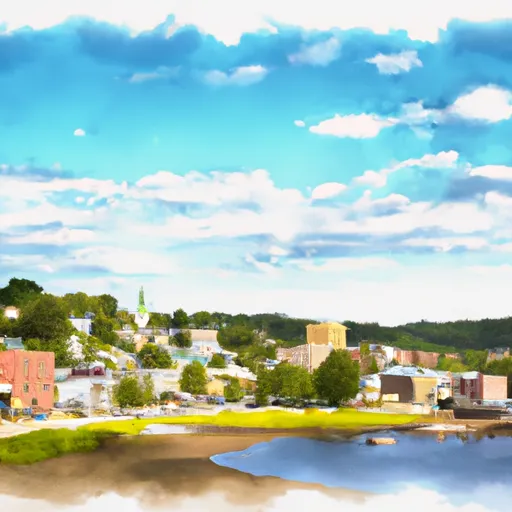-
 Snoflo Premium
Snoflo Premium
Get unlimited access to all our content
With no Ad interruptions! - Start Your Free Trial Login with existing account
Van-Buren
Eden Index
Climate
6.2
•
Recreation
•
Community
1.8
•
Safeguard
2.9/10

Van Buren, Maine, is a picturesque town located in Aroostook County. Known for its beautiful landscapes and outdoor activities, Van Buren experiences a continental climate with cold winters and warm summers. The average temperature in winter hovers around 15°F (-9°C), while summers reach an average high of 77°F (25°C). The town also receives an annual average precipitation of around 40 inches, with snowfall being a prominent feature during the winter months.
Van Buren boasts an abundance of hydrology constituents due to its location near the St. John River. This river is not only a stunning feature of the town's landscape but also provides excellent opportunities for recreational activities such as fishing, boating, and kayaking. The river's diverse aquatic life attracts fishing enthusiasts who can find an abundance of species like smallmouth bass, northern pike, and yellow perch.
In addition to water-based activities, Van Buren offers various outdoor recreation opportunities. Outdoor enthusiasts can explore the surrounding forests through hiking and biking trails, taking in the breathtaking scenery and observing the local wildlife. During winter, the town becomes a haven for cross-country skiing, snowmobiling, and snowshoeing, with well-maintained trails for all skill levels.
Overall, Van Buren, Maine, with its favorable climate, hydrology constituents, and diverse outdoor activities, provides an ideal destination for nature lovers and adventurers alike.
What is the Eden Index?
The Snoflo Eden Index serves as a comprehensive rating system for regions, evaluating their desirability through a holistic assessment of climate health, outdoor recreation opportunities, and natural disaster risk, acknowledging the profound impact of these factors on livability and well-being.
Climate Health Indicator (CHI): 6.2
Van-Buren receives approximately
994mm of rain per year,
with humidity levels near 79%
and air temperatures averaging around
4°C.
Van-Buren has a plant hardyness factor of
3, meaning
plants and agriculture in this region thrive during a short period during spring and early summer. Most
plants will die off during the colder winter months.
By considering the ideal temperature range, reliable water supplies, clean air, and stable seasonal rain or snowpacks, the Climate Health Indicator (CHI) underscores the significance of a healthy climate as the foundation for quality living.
A healthy climate is paramount for ensuring a high quality of life and livability in a region, fostering both physical well-being and environmental harmony. This can be characterized by ideal temperatures, reliable access to water supplies, clean air, and consistent seasonal rain or snowpacks.
Weather Forecast
Streamflow Conditions
St. John
Area Rivers
St. John
Snowpack Depths
St. John
Reservoir Storage Capacity
St. John
Groundwater Levels
Recreational Opportunity Index (ROI):
The Recreational Opportunity Index (ROI) recognizes the value of outdoor recreational options, such as parks, hiking trails, camping sites, and fishing spots, while acknowledging that climate plays a pivotal role in ensuring the comfort and consistency of these experiences.
Access to outdoor recreational opportunities, encompassing activities such as parks, hiking, camping, and fishing, is crucial for overall well-being, and the climate plays a pivotal role in enabling and enhancing these experiences, ensuring that individuals can engage in nature-based activities comfortably and consistently.
Camping Areas
| Campground | Campsites | Reservations | Toilets | Showers | Elevation |
|---|---|---|---|---|---|
| Aroostook State Park | None | 660 ft |
Nearby Ski Areas
Catastrophe Safeguard Index (CSI):
The Catastrophe Safeguard Index (CSI) recognizes that natural disaster risk, encompassing floods, fires, hurricanes, and tornadoes, can drastically affect safety and the overall appeal of an area.
The level of natural disaster risk in a region significantly affects safety and the overall livability, with climate change amplifying these risks by potentially increasing the frequency and intensity of events like floods, fires, hurricanes, and tornadoes, thereby posing substantial challenges to community resilience and well-being.
Community Resilience Indicator (CRI): 1.8
The Community Resilience Indicator (CRI) recognizes that education, healthcare, and socioeconomics are crucial to the well-being of a region. The CRI acknowledges the profound impact of these elements on residents' overall quality of life. By evaluating educational resources, healthcare accessibility, and economic inclusivity, the index captures the essential aspects that contribute to a thriving community, fostering resident satisfaction, equity, and social cohesion.

